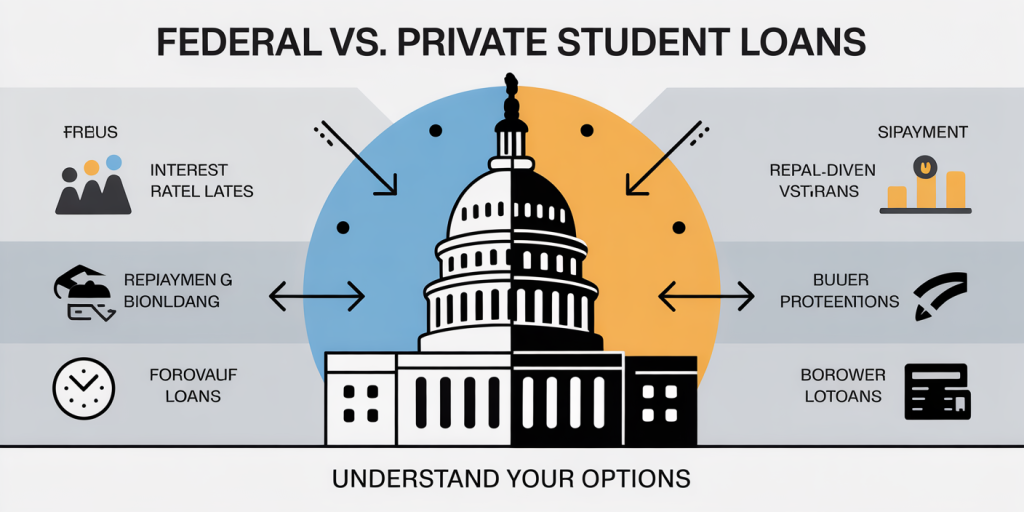Managing student loans during college can be a daunting experience for many students. With rising tuition fees and the increasing cost of living, student debt has become a major concern for millions across the globe. According to the Federal Reserve, as of 2023, approximately 45 million Americans hold nearly $1.7 trillion in student loan debt. Proper management of these loans while still in school can significantly ease financial burdens later and pave a smoother path to financial independence.
To effectively manage student loans, students must adopt strategies that emphasize budgeting, loan understanding, and smart borrowing decisions. This article explores practical methods to keep student borrowing in check, minimize interest accumulation, and prepare for a debt-free post-graduation life.
Understanding Your Student Loans: Types and Terms
Comprehending the basics of your student loans is the first crucial step in managing them responsibly. Student loans typically fall into two categories: federal and private loans. Federal loans are funded by the government and generally offer better interest rates, flexible repayment options, and protections like income-driven repayment plans. Private loans, on the other hand, usually come from banks or credit unions, often with higher interest rates, and fewer borrower protections.

For example, a federal Direct Subsidized Loan does not accrue interest while the student is enrolled at least half-time, which means the government pays the interest during that period. Conversely, private loans often begin accumulating interest from the date of disbursement, which can significantly increase the total amount owed. According to the National Center for Education Statistics, nearly 30% of undergraduates use private loans, yet many underestimate the implications of higher rates and less flexible repayment options.
It is equally important to understand the terms such as the loan amount, interest rate, grace period, and repayment options. Knowing your outstanding balance, the amortization schedule, and how interest compounds can empower you to make wise decisions, like opting to pay interest early where possible to avoid capitalization (interest added to the principal balance).
Creating a Budget That Incorporates Loan Management
Budgeting is a cornerstone of effective student loan management. Many students fail to allocate loan disbursements wisely, leading to overspending on non-essential items and unexpected financial stress. Setting up a detailed monthly budget enables students to prioritize necessary expenses like tuition, textbooks, housing, and food while allowing room to address loan payments or interest.

A practical example involves Sarah, a college sophomore who uses her student loan funds for tuition and housing only and works part-time to cover additional expenses. She tracks her monthly expenses through budgeting apps such as Mint or YNAB (You Need A Budget), which offers real-time updates and notifications. By visualizing her cash flow, Sarah can balance living costs while minimizing unnecessary debt accumulation.
Below is a comparative table showing typical student expenses and how incorporating a loan repayment strategy influences budgeting:
| Expense Category | Without Loan Management | With Loan Management (includes $100 interest payments) |
|---|---|---|
| Tuition & Fees | $1,200/month | $1,200/month |
| Housing | $700/month | $700/month |
| Food | $300/month | $250/month (meal prep to save costs) |
| Transportation | $100/month | $80/month (uses campus shuttle to save) |
| Loan Interest Payment | $0 | $100/month |
| Entertainment & Misc. | $200/month | $100/month (limits outings) |
| Total | $2,500/month | $2,430/month |
By intentionally incorporating small interest payments during school, students can dramatically reduce the future loan balance.
Strategies to Minimize Loan Debt While in School
Minimizing total debt starts with borrowing only what you absolutely need. Many students tend to accept the full loan amount offered, regardless of necessity. This habit can result in excessive debt that takes years to repay. Actively managing loan amounts and supplementing income through employment or scholarships can reduce the borrowing burden.
Consider James, a junior who applied for scholarships totaling $3,000 each year and maintains a 15-hour workweek on campus, earning around $1,200 monthly. By doing so, he reduced his annual loan borrowing by nearly 25%. Utilizing resources like the College Board’s Scholarship Search, state grants, and work-study programs can supplement finances effectively.
Moreover, choosing less expensive housing or sharing accommodations saves money that could otherwise push students to borrow more. Also, buying used textbooks or renting digital copies can cut costs by up to 60%, further reducing financial strain.
Federal data shows that students who have part-time jobs while studying are 20% less likely to borrow excessive student loans. Yet, balancing work and academics is key; excessive hours can impact academic success, which indirectly affects financial aid eligibility.
Managing Loan Interest and Repayment Options During School
While many federal student loans have a grace period or deferment options that postpone repayment until after graduation, interest accrual can still be a concern. For unsubsidized loans, interest starts accruing immediately upon disbursement. Accrued interest can capitalize—added to the principal and compounded—if unpaid, increasing the total debt exponentially.
A case study involving a recent graduate, Megan, highlights this risk. Megan had $20,000 in unsubsidized federal loans and did not make any interest payments during her 4 years in school. Upon graduation, her loan balance had ballooned to approximately $24,000 due to capitalized interest, prolonging her repayment timeline and increasing monthly payments.
To avoid this, students should consider making interest-only payments while in school. Even paying a small amount monthly can prevent interest from capitalizing. Many loan servicers offer monthly statements or online account management tools, which can facilitate tracking of interest accrual and setting up payment plans.

For instance, the income-driven repayment plans available for some federal loans allow borrowers to begin payments based on income rather than a fixed schedule after schooling, providing flexibility. However, proactive communication with loan servicers is critical to understand your options and avoid default.
The Role of Credit and Loan Refinancing Options
Managing student loans responsibly while in school can positively impact credit scores, which is crucial for refinancing post-graduation. Building a good credit history through on-time payments and low loan balances improves the chance of qualifying for refinancing with lower interest rates, thereby reducing overall debt.
Refinancing allows borrowers to consolidate multiple loans and secure better terms. For example, companies like SoFi, CommonBond, and Earnest offer refinancing options primarily based on creditworthiness and employment status. According to a 2023 report by LendingTree, borrowers with credit scores above 700 can typically lower their interest rates by 0.5-2% through refinancing.
Students who pay interest during school and avoid late payments demonstrate financial responsibility, contributing positively to their credit rating. However, it is vital to understand that refinancing federal loans with private lenders may result in losing federal protections such as income-based repayment plans or loan forgiveness options.
Therefore, evaluating long-term objectives and consulting financial advisors or university counseling services before refinancing is advisable.
Looking Ahead: Future Trends in Student Loan Management
The landscape of student loans and financial aid is continuously evolving. Recent legislative proposals, such as expansions of income-driven repayment and loan forgiveness programs, aim to alleviate the student debt crisis in the United States. Additionally, fintech innovations are creating more accessible and personalized loan management tools, empowering students to monitor and optimize their debt in real time.
Emerging platforms equipped with AI-driven analytics can forecast repayment scenarios and recommend tailored strategies, far beyond traditional budgeting apps. For instance, some tools can simulate the financial impact of working extra hours, applying for scholarships, or making interest payments, helping students make data-informed decisions.
Moreover, the increasing prevalence of hybrid or online learning models may reduce overall education costs for some, thereby minimizing future loan needs. Continuous advocacy for affordable education and transparent loan terms also points to a future where managing student loans becomes more straightforward and less burdensome.
For students currently in school, staying informed and adaptable remains essential in navigating the evolving frameworks and maximizing available resources.
Managing student loans during your academic journey may feel overwhelming, but with strategic planning, budgeting, and informed loan management, students can significantly alleviate future financial stress. Awareness of loan types, interest accrual, budgeting discipline, and proactive repayment measures contribute to sustainable debt handling. Moreover, keeping an eye on future loan policies and leveraging new technologies can empower today’s students to graduate not only with knowledge but with financial confidence.
Deixe um comentário